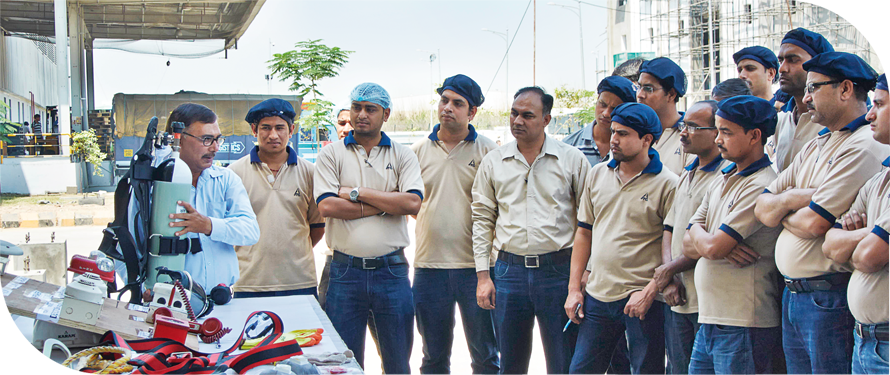Sustainability Challenges
Sustainability Risk Portfolio
A business wise identification of sustainability risks has been carried out across various sectors in which ITC operates. This was based on reviews of various relevant publications, inputs provided by stakeholders and consultation with domain expert agencies. Sustainability challenges for ITC can be classified into two broad categories – those that are influenced by global events, and challenges that are unique to developing nations like India. It becomes essential to understand in this context that while India mirrors many of the global challenges, issues like poverty, social inequities, unemployment and environmental degradation assume even more acute and multi-dimensional characteristics in India.
Global Challenges
The sustainability agenda of developed nations is quite naturally shaped by events that have had the largest impact on them. These include the recent financial meltdown, job losses in the manufacturing sector and a looming demographic crisis due to an aging population.
It is also well acknowledged that challenges like climate change and global warming are affecting the entire planet. However the anticipated and real impacts for the developed world and developing countries are vastly different, both in scale and scope. These differences are multi-layered and multi-faceted given the dimensions of the challenges and the socio-economic environment prevailing in different countries. Given this context, countries like India while cognising for the larger global challenges, will have to shape their own sustainability agenda with focus on specific issues that have a direct impact on the Indian society at large.
The Indian Context
In India, these social and environmental challenges are even more daunting. Even though India recently displaced Japan to become the world's third largest economy in terms of Purchasing Power Parity (PPP), a third of the world's poor still live in India, according to a 2013 UN Report. Global challenges on the social front assume even greater significance in India which is home to 17% of the world's population, with only 2.4% of the world's land share. India is already facing challenges of overpopulation and lack of proper education as well as a paucity of employment opportunities for the large population of youth that is now potentially part of India's demographic dividend. The need of the hour is an enabling policy framework that supports the expansion of employment opportunities and cognises for the emerging market dynamics and the socio-economic environment. Of equal concern is India's continued downward slide on the Human Development Index and priority must be provided to reducing child and mother mortality, improving access to sanitation and quality education and reducing the inequalities of opportunity to enable people to lead a decent life.
On the environmental front, the latest report by the Intergovernmental Panel on Climate Change (IPCC) projects a large reduction in wheat yields in the Indo-Gangetic Plains. The report goes on to forecast a disruption of livelihoods, risk to terrestrial and marine ecosystems and risks of mortality, morbidity, and other harms during periods of extreme heat. In addition, factors like water scarcity, pollution of water sources, top soil loss, reduction in forest cover, among others, will negatively impact the already marginal existence of millions, especially in rural India. Unless these issues are tackled on an urgent footing, India may well become a powder keg of social unrest that will impact its long-term prospects as a country with immense potential for large-scale economic, social and environmental growth.
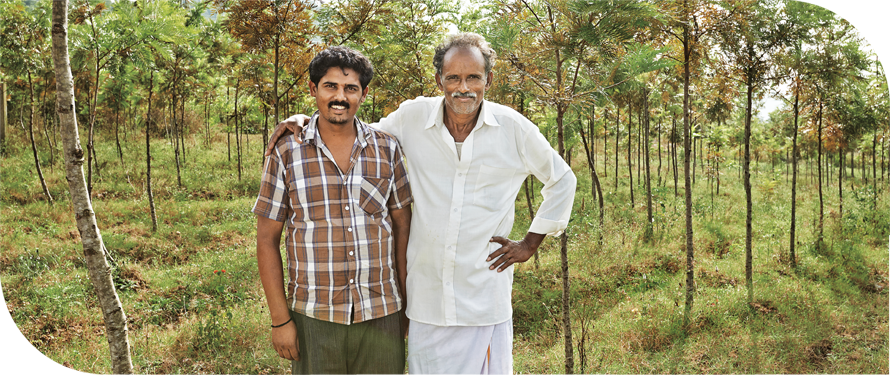
Taxation and Regulation - Cigarettes
India's Unique Pattern of Tobacco Consumption
India has a unique pattern of tobacco consumption where the share of legal cigarettes in overall tobacco consumption is below 12%. The balance of tobacco consumption is represented by a host of traditional products such as various forms of chewing tobacco, bidis etc. As a result, India has the lowest per capita consumption of cigarettes in the world. While India accounts for over 17% of world population, it has a miniscule share of only 1.8% of global cigarette consumption but constitutes nearly 84% of the global consumption of smokeless tobacco.
India's tobacco control policies, however, are incompatible with its unique pattern of consumption as they have been dictated by a Western model of tobacco consumption, which is urban centric and where cigarettes represent over 90% of tobacco consumption.
The demand for cigarettes in India is highly price elastic and this is borne out by the fact that tobacco consumption in the form of legal cigarettes declined from 86 million kg. in 1981-82 to 68 million kg. in 2013-14 even as total tobacco consumption in the country increased from 406 million kg. in 1981-82 to 577 million kg. in 2013-14 during the same period. Thus, while overall tobacco consumption is increasing in India, the share of legal cigarettes in overall tobacco consumption has declined from 21% to below 12%.
High Rates of Taxation
The Cigarette industry had to contend with a steep increase in Excise Duty for two years in succession along with discriminatory and punitive increases in Value Added Tax (VAT) rates by some States. Such tax increases not only undermine the legal domestic cigarette industry and sub-optimise revenue potential from this sector but also fail to achieve the objective of tobacco control in the country.
According to various independent reports, there is a high degree of dual consumption with a significant number of cigarette consumers in India also consuming other forms of tobacco. High incidence of taxation and a discriminatory regulatory regime on cigarettes have, over the years, led to a significant shift in tobacco consumption to cheaper and revenue inefficient forms like bidis, chewing tobacco etc.
Illicit Trade
The policy of high taxation narrowly focussed on cigarettes also led to the rapid growth of illegal cigarettes in India. According to various studies, India is the 5th largest illicit cigarette market in the world. This has resulted in a significant revenue loss for the government, estimated by FICCI at around ` 6,000 crores. The size of the illegal industry in India, comprising smuggled foreign and domestic tax-evaded cigarettes, is currently estimated at 24.3 billion sticks per annum representing 19% of the overall cigarette market.
As per various international studies, illegal tobacco trade ranks among the top three organised criminal activities in the world.
High taxes on domestic cigarettes have led to an increasing demand for cheaper tax-evaded cigarettes. Therefore there is an urgent need for an equitable and balanced tax regime to enhance the revenue potential of tobacco and discourage the growing illicit trade. This can only be done by providing tax stability on cigarettes, while simultaneously widening the tobacco tax base.
ITC's Initiatives
- ITC will continue to engage with policy makers through industry associations for a balanced regulatory and fiscal framework for tobacco, equitable and harmonious VAT rates across States and implementation of a uniform GST rate.
- It has been ITC's strategic intent to create multiple drivers of growth by building a portfolio of world-class businesses in Fast Moving Consumer Goods, Paperboards, Paper and Packaging, Agri Business, Hotels and Information Technology, leveraging enterprise strengths such as consumer insights, innovative product development, brand building, state-of-the-art manufacturing, efficient supply chain and distribution infrastructure and sustained investments in R&D.
Impact on Livelihoods of Farmers
- The Tobacco industry provides direct and indirect employment to 38 million people in India, primarily in the agriculture sector.
- Tobacco continues to be a viable and remunerative crop for farmers in the regions where this crop is grown, given the prevailing agro-climatic nature and soil conditions of these regions. It gives farmers an assured income and good institutional support is also available for this crop.
- The disproportionately high taxation on cigarettes fuels transborder smuggling, leading to a reduction in domestic demand and impacts the market price for the farm produce. This adversely impacts the livelihood of farmers in general and the dependent community in particular. Tobacco farmers are important constituents of the tobacco industry.
- Increasing volumes of smuggled foreign cigarettes also result in the decline in demand for Indian tobaccos since these cigarettes do not use any Indian tobaccos. On the other hand, illegal cigarettes produced in India use tobaccos of dubious and inferior quality. Consequently, the proliferation of duty evaded cigarettes not only has an adverse impact on demand for high-quality Indian tobaccos but also a cascading impact on incomes of Indian farmers, long term viability of the legal cigarette industry as well as Government revenues.
Challenges Impacting Agriculture and Agri Business
- Agriculture in India engages around 50 per cent of the country's workforce and supports the livelihoods of 75 per cent of the population living below the poverty line.
- The sector consumes 80 per cent of the nation's fresh water resources, a quarter of the total electricity and more than 70 per cent of central government subsidies.
- However, it accounts for just about 14 per cent of GDP. Woefully therefore, the farmer's per capita income is less than one-fifth of the rest of the country's average.
- Such low incomes are a result of a deteriorating natural resource base, disconnected value chains, fragmented landholdings, weak infrastructure, inadequate knowledge and multiple intermediaries.
- In addition, around 55% of India's total sown area meets its requirements from rainwater alone. This assumes importance in the face of environmental challenges of erratic rainfall leading to drought and floods. A majority of the farmers are hence trapped in a vicious cycle of low productivity and low investments.
- A long-term view of tackling these issues entails a mosaic of alternative solutions at the policy level, which address the issue in the short, medium and long terms. These measures will also ensure larger private participation and investments leading to a large-scale revival of this sector.
- Constraints like non-implementation of the 'Model APMC' Act recommended by the Centre leads to multiple levels of transportation, handling expenses, and commissions of various agents. This essentially adds nearly 20% cost, through non-value-adding activities. The Model Act facilitates a direct interface between farmers and agri businesses and helps in reducing transaction costs by allowing alternative marketing models to co-exist, including providing farmers with the freedom to sell at the farm gate.
Challenges Impacting Agriculture and Agri Business
- Anywhere from 5% to 40% of food is wasted along the chain, depending on the inherent perishability of the crop and the season. It is possible to reduce this kind of wastage through methods to determine future prices and align production accordingly. Market instruments must therefore empower the farmers to produce as per tomorrow's demand, rather than be guided by yesterday's prices that results in wastages due to supply-demand imbalances.
- This is further aggravated by limitations that are imposed by the Forward Contracts (Regulation) Act. While it is acknowledged that strong regulation is necessary to curb excessive speculation, the Act doesn't allow sufficient flexibility for genuine players and deprives them of critical risk management tools, such as options. Options assure farmers of a minimum price at the time of sowing itself, based on the future projections simulated by a market consensus. This aligns the production volumes to the future demand conditions and minimises the shortages as well as avoidable wastages.
- Considerable investment is also required to build infrastructure like climate-controlled storages and transport facilities to prevent wastage. The private sector certainly has the capacity to invest and add value to such infrastructure. However, regulations like the Essential Commodities Act (ECA), which impose stock limits and curb movements from time to time, create uncertainty in business viability, acting as a huge deterrent to such long-term investments.
- It is also essential to facilitate value-addition to farm produce, especially food, by way of processing on a large-scale. This will enable farmers to cash in on the consumption dividend offered by today's quality-conscious, convenience-preferring, variety-seeking, and safety-concerned consumers.
- Given that a large part of India's total sown area meets its requirements from rainwater alone, it is imperative to invest in a wide spectrum of technology interventions that will make agriculture climate and weather proof. These include introduction of specially-developed varieties of seeds that withstand extreme weather, diverse soil conditions and various biotic stresses. In addition, scientific practices like precision farming, micro-irrigation, watershed development and power-efficient farm mechanisation need proliferation through focussed incentivisation.
- Solutions like crop and weather insurance are also essential to whet the risk-taking capability of the farmer, who can then invest to step up productivity, participate more effectively in agricultural value chains and garner a larger share of consumer spends.
- ITC operates across the agri value chain of 13 crops and is present in 17 states with substantial investments in resource intensive models that entail heavy capital infrastructure. These agri value chains that have empowered over 4 million farmers have been severely constrained by such restrictive regulations that do not distinguish between genuine agri businesses and unscrupulous hoarders.
- Policy reforms also need to encourage large-scale investments by the private sector, which can provide a much needed boost to this sector.
- There is also need for an enabling policy framework that boosts the provision of rural infrastructure so that wastage can be eliminated and farmers can receive better returns.
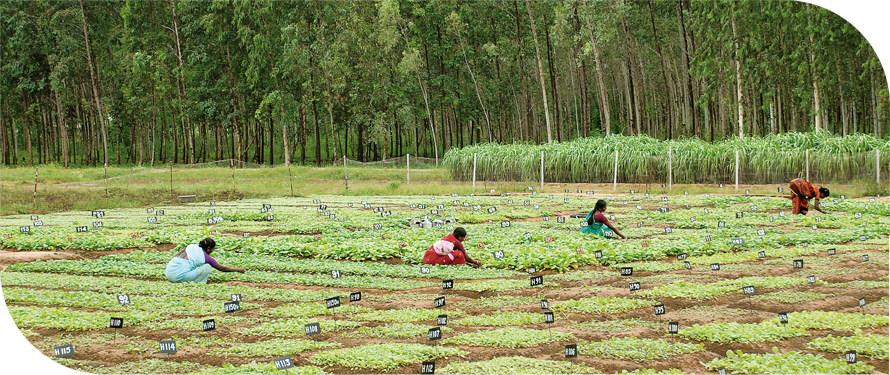
ITC's Initiatives
- ITC has empowered farmers and forged strong relationships with rural communities to enable sustainable sourcing solutions for over several decades. Recognising that poverty in rural India is primarily a result of the poor capacity of farmers in terms of lack of access to knowledge, information, price discovery, quality agricultural inputs and markets, the Company has devised unique models for agri sourcing that not only support sustainable agriculture but also contribute to substantial livelihood creation for inclusive development. In addition, ITC's Social Investments Programmes, including integrated watershed development, support the adoption of sustainable agricultural practices.
- ITC's e-Choupal network, which leverages information technology to empower farmers, is a rich repertoire of agri-based interventions and not only addresses the core needs of farmers in terms of infrastructure, connectivity, price discovery and market access, but also provides a significant boost to farm productivity through extension services and research-based agri-inputs. Initiatives like the 'Choupal Pradarshan Khet' bring suitable agricultural best practices to farmers and have demonstrated significant productivity gains. These interventions have helped transform village communities into vibrant economic organisations by enhancing incomes and co-creating markets. ITC's e-Choupals serve 40,000 villages and 4 million farmers, making it the world's largest rural digital infrastructure.
- ITC will continue to engage with policy makers through industry associations, organisations and other appropriate forums for enabling a balanced and pragmatic policy framework that not only removes restrictive conditions on the efficient functioning of agri businesses but also facilitates the establishment of market-based institutions that can raise agricultural productivity and optimise transaction costs across the value chain.
Climate Change and Environmental Degradation
- The race for unbridled economic growth has left a planet seriously depleted of environmental resources.
- The world's ecological footprint suggests that consumption of natural resources every year will be far more than the earth's capacity to regenerate.
- With increasing population, people will have access to limited resources which will be far less than what was available in 1950.
- The impact of climate change is manifest in the changed weather patterns and increasing frequency of extreme weather conditions. This affects agricultural production and severely impacts the livelihoods of farmers. Given that several of ITC's businesses are dependent on agricultural inputs, climate change and global warming have important ramifications for the Company and some of its major stakeholders – the farmers and communities in rural India.
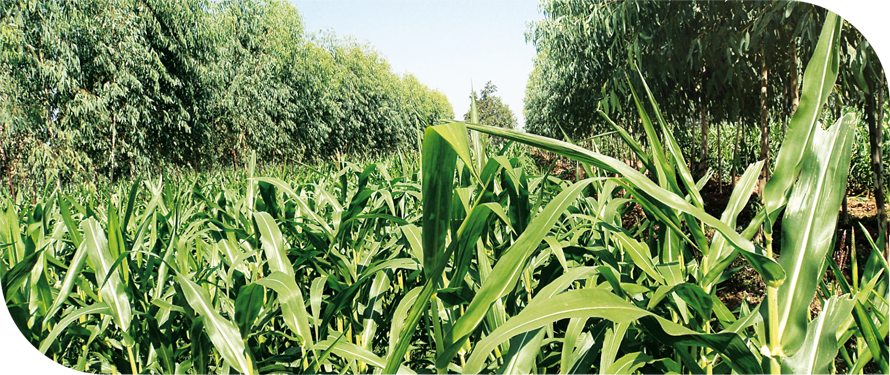
ITC's Initiatives
- ITC has adopted the following strategies for climate change mitigation:
- Identify and evaluate climate change risks for each business.
- Reduce the environmental impact of our processes, products and services and work towards creating a positive environmental footprint.
- Adopt a low-carbon growth path through reduction in specific energy consumption and enhancing use of renewable energy sources.
- Enlarge our Carbon Positive footprint through increased carbon sequestration by expanding forestry projects in wastelands.
- Reduce specific water consumption and augment rainwater harvesting activities both on site and off site at watershed catchment areas.
- Work towards minimising waste generation, maximising reuse & recycling and using external post-consumer waste as raw material in our units.
- Create sustainable livelihoods and promote sustainable agricultural practices.
Life Cycle Assessment studies have been carried out for different products to understand the impact across the value chain. Resource efficiency is integrated into product and process design and is addressed in the creation of physical infrastructure, the operations phase, logistics and waste management.
The adoption of these strategies has led to the following outcomes:
- ITC has expanded its renewable energy portfolio with 38.1% of its energy consumption being met from renewable sources.
- As part of its low-carbon and green growth strategy, ITC has spearheaded the establishment of green buildings, which have set benchmarks in energy efficiency, water conservation and solid waste recycling. All ITC's super premium luxury hotels are LEED® Platinum certified. The ITC Green Centre, Gurgaon has been identified as the highest Platinum rated Green Building in the world by the US Green Building Council during its recertification in 2012. ITC's iconic property in Chennai, ITC Grand Chola, is now the largest LEED® Platinum rated green hotel in the world.
- ITC's afforestation programme has greened over 1,63,000 hectares, which has led to large-scale carbon sequestration besides creating over 70 million person days of employment.
- ITC's watershed development programme provides soil and moisture conservation to 1,49,000 hectares. This has enabled the Company retain its Water Positive status for 12 years in a row.
- ITC's Wealth Out of Waste programme promotes recycling and source segregation and creates awareness among all stakeholders on the benefits of the Reduce-Reuse-Recycle Approach. This initiative has enabled ITC's paperboards business to source and recycle post-consumer waste, thereby contributing to ITC's Solid Waste Recycling Positive status.
Poverty and Social Inequities
- Nearly 700 million people living in rural India, with low adaptive capacities, have a direct and symbiotic dependence on climate sensitive sectors (agriculture, forest and fisheries) and natural resources (water, bio-diversity, mangroves, coastal zones and grasslands) for their subsistence and livelihood. The limited options of alternative off-farm employment, combined with endemic poverty, continue to imperil the livelihood of millions of small and marginal farmers, mainly in the rain-fed agriculture regions. The production regime in rain-fed agriculture is inherently fragile and getting more so due to a number of factors:
- An estimated 147 million hectares suffer from various forms of land degradation due to water and erosion, stemming mainly from unstable use and inappropriate land management practices. Erosion rates are reported to be in the range of 5 to 20 tonnes/hectares.
- As many as 99 districts spread over 14 states were identified by the Central Water Commission as drought prone. Such areas are concentrated in the states of Rajasthan, Karnataka, Andhra Pradesh, Gujarat and Madhya Pradesh.
- Of the total water available for agriculture, groundwater alone accounts for 39% of the water used in agriculture. Yet the Central Ground Water Board reported that 1,565 blocks (one-third of the total) ranged from semi-critical to over-exploited groundwater status.
- Based on the current evidence, there is a compelling case to argue that these factors are likely to get exacerbated due to threat of climate change, leading to an increase in the frequency and intensity of droughts and floods. Climate change over the long-term will thus affect the rural economy in a number of ways – the majority of which would threaten food security for the most vulnerable people.
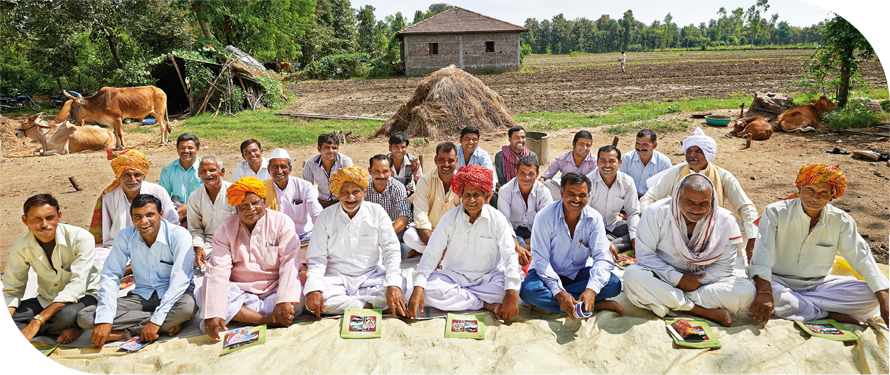
ITC's Initiatives
- Recognising that business enterprises are the economic organs of society and draw on societal resources, ITC believes that a company's performance must be measured by its Triple Bottom Line contribution to building economic, societal and environmental capital. ITC is, therefore, committed to creating larger 'stakeholder value' by aligning its performance to such Triple Bottom Line objectives. As an Indian enterprise, the Company believes that this approach can unleash strong growth drivers to ensure inclusive and equitable development as well as long-term business sustainability and competitiveness.
- ITC has implemented an extensive social investments programme in geographies where it has strategic business interests and presence. To ensure long-term sustainability of these investments and to enable replication and scalability, these programmes have been implemented in the context of value chains of the Company.
- The programmes strive to empower stakeholder communities to conserve and manage their natural resources, create sustainable on and off-farm livelihood sources and improve social infrastructure in order to support creation of sustainable livelihoods on a significant scale backed by an empowered stakeholder community.
- The scale and impact of these initiatives are reflected in the following:
- ITC's e-Choupal network has benefitted over 4 million farmers in 40,000 villages.
- ITC's Social and Farm Forestry Programme has created over 70 million person days of employment for poor tribals and marginal farmers.
- ITC's Watershed Development Programme covers 1,49,000 hectares of moisture-stressed areas.
- ITC's Livestock Development Programme has reached out to over 10,00,000 milch animals.
- ITC's Women's Empowerment Programme has benefitted over 40,000 rural women.
- ITC's Supplementary Education Programme has covered over 3,00,000 children.
Supply Chain Management
- The engagement with our supply chain has expanded given the growth of our new consumer goods businesses and it will be important to integrate the Triple Bottom Line approach amongst the supply chain to ensure long-term competitiveness by adopting a balanced approach towards creation of livelihoods and economic viability of these units.
- Our supply chain comprises a large number of small-scale partners. Many of them operate under limiting circumstances in terms of their ability to invest in efficient technologies and their necessity to rely on labour intensive practices. It will be important to integrate the Triple Bottom Line approach amongst the supply chain for long-term competitiveness by adopting a balanced approach towards creation of livelihoods and economic viability of the small scale units.
ITC's Initiatives
- The Company's engagement with the supply chain is being extended in a structured and phased manner.
- ITC encourages its supply chain to comply with certifications, such as ISO 9001, ISO 14001 and OHSAS 18001, to strengthen their quality, environmental and occupational health & safety systems.
- The recent Board approved policies on Responsible Sourcing and Human Rights consideration of Stakeholders beyond the Workplace, provide the necessary framework for the progressive extension of the Company's Triple Bottom Line approach across the supply chain over the next few years.
Addressing Issues Related to Employee Safety
- Given India's favourable demographic dividend, it is evident that a large pool of India's youth is joining the workforce every year. It is critically important for an organisation to ensure the total safety of this valuable resource. While we are progressing steadily towards our target of zero accidents within our premises, we cognise that accidents outside the workplace are on the rise in India, given issues such as the steady proliferation of 2 wheelers on the roads, which are rendered unsafe due to poor conditions and inadequate infrastructure.
ITC's Initiatives
- ITC has made significant investments over the years to ensure that all its business units provide a safe, hygienic and humane environment to its employees. These are done on the basis of detailed engineering and management guidelines which are based on best international standards. To further strengthen efforts in this area, Safety Culture programmes are being institutionalised and behavioural architecture inputs are being used to rework and recalibrate EHS communication and training methodologies. Training on EHS is provided to all employees (including service providers' employees) and covers basic induction, job specific and refresher training.
- It has been observed over the years that the majority of road accidents have involved two wheelers and employees in the age group of 26-30 years. Accordingly a user-interactive 2-wheeler rider's safety programme was developed and rolled out in 2011-12. Businesses were advised to ensure that all employees using 2-wheelers are trained and that there is a constant reinforcement of the message of exercising extreme care while on the road. These efforts have resulted in a sharp reduction in road accidents. Despite the fact that road infrastructure and traffic management outside ITC's premises are well beyond our control, ITC is providing a special thrust on training and awareness building by translating the interactive ITC 2-wheeler rider's safety programme into local languages to ensure 100% coverage of all employees.
